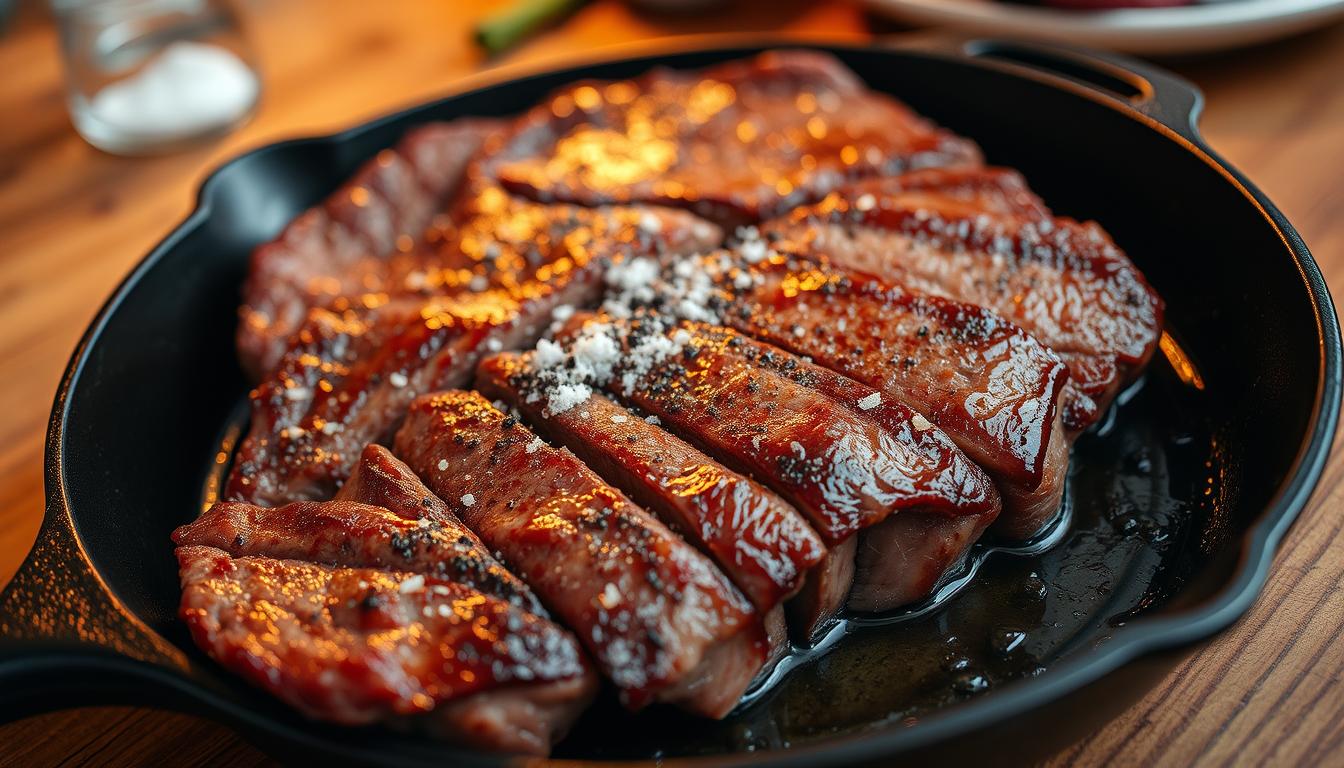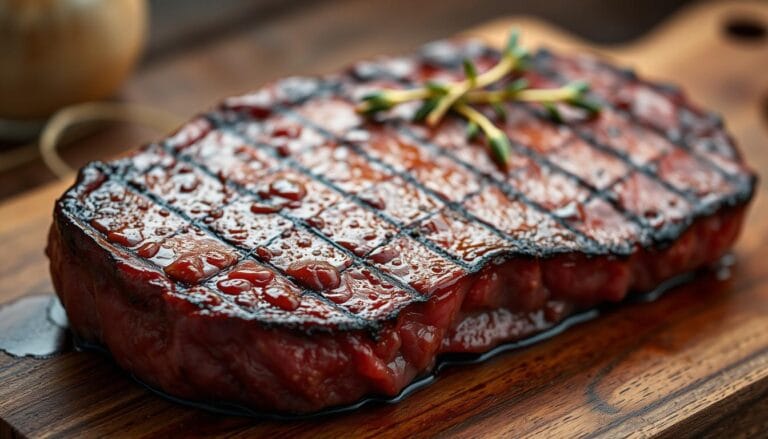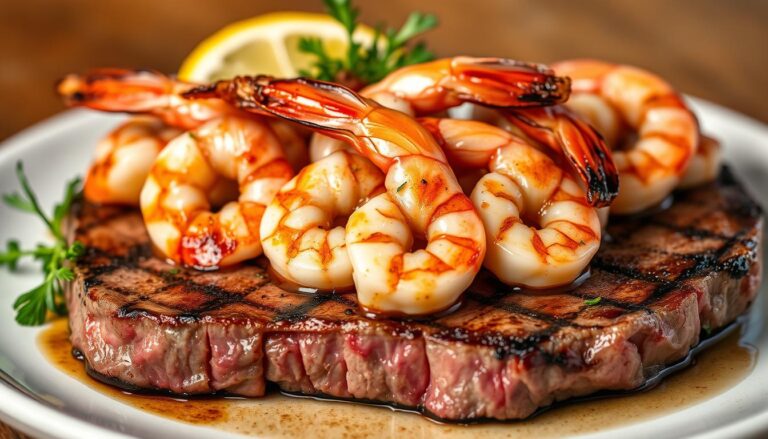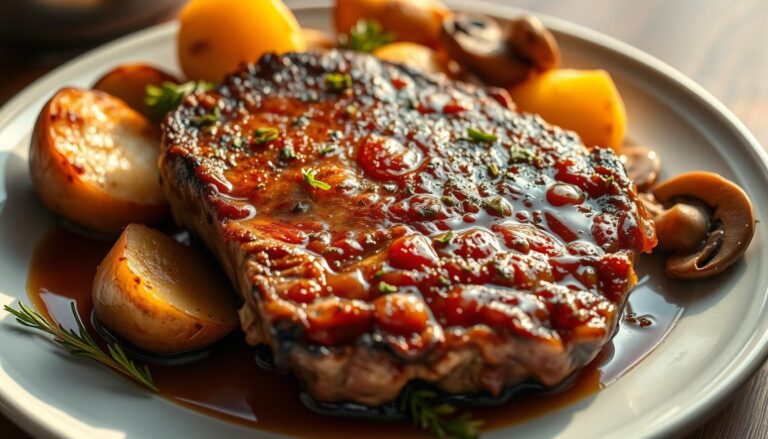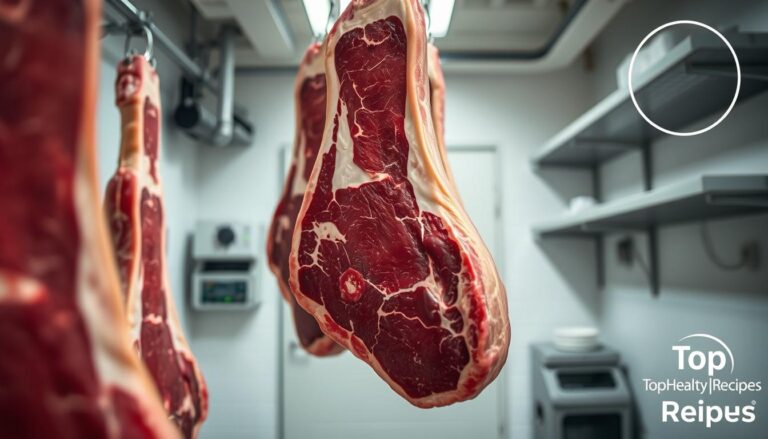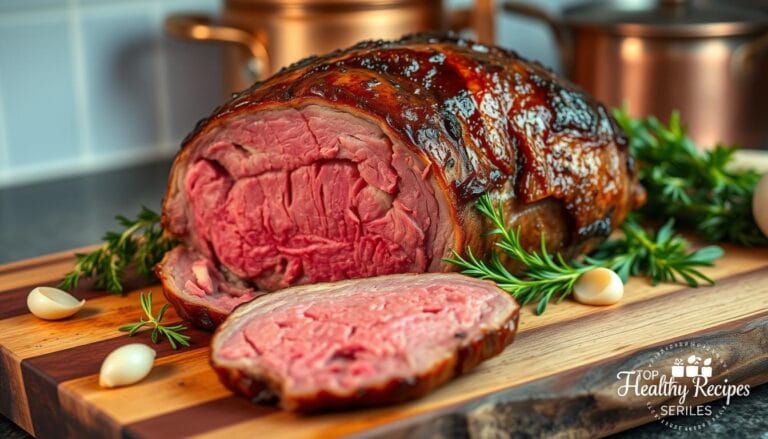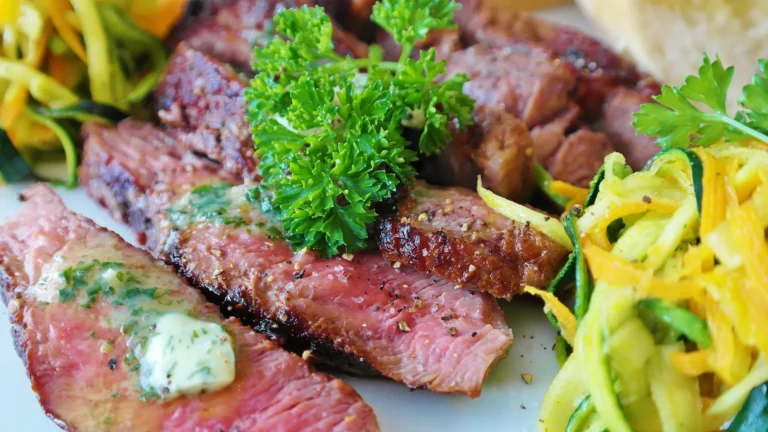How to Cook Denver Steak to Perfection with These Tips
Table of Contents
How to Cook Denver Steak to Perfection with These Tips
Imagine enjoying a tender, flavorful Denver steak just the way you like it. It’s easier than you think, thanks to the right techniques.
Whether you’re a pro chef or a home cooking enthusiast, cooking the perfect Denver steak can make your meals special. This cut is often overlooked but offers a rich taste and soft texture when cooked right.
By using expert tips on picking the right cut, seasoning, and different cooking methods, you’ll make a dish that wows everyone. It’s perfect for impressing your family and friends.
Key Takeaways
- Understand the characteristics of a great Denver steak
- Learn expert seasoning techniques for enhanced flavor
- Explore various cooking methods for optimal results
- Discover serving suggestions to elevate your dining experience
- Impress your guests with a perfectly cooked Denver steak
What is Denver Steak and Why Choose It?
Denver steak is a new steak option that’s tender and full of beef flavor. It’s loved by chefs and home cooks for its quality and price.
The Denver steak comes from the chuck primal of the cow, a part that’s not used much. This makes it tender and full of flavor, even though it’s from a tougher section.
Origin and Cuts of Denver Steak
The Denver steak comes from the chuck primal, but it’s from a specific muscle that’s not worked hard. This makes it tender and a great value compared to pricier steaks like ribeye or strip steak.
When picking Denver steak, look for good marbling. Marbling makes the steak juicy and flavorful, no matter how you cook it.
Flavor Profile and Tenderness
The Denver steak has a rich, beefy flavor and is very tender. Its marbling makes it juicy and flavorful, making it a great choice for any cooking method. When cooked right, it’s as good as more expensive steaks.
“The Denver steak’s unique muscle structure contributes to its tenderness when cut correctly and cooked properly.”
Knowing what makes Denver steak special helps you see why it’s a favorite. Its mix of flavor, tenderness, and price makes it perfect for steak lovers.
Preparing for Cooking Denver Steak
To cook a Denver steak perfectly, start with careful preparation and the right ingredients. You need to pick the right cut and have the right tools.
Choosing the Right Cut
Look for Denver steaks with good marbling for more flavor and juiciness. Marbling is the small white fat flecks in the meat. They make the steak taste better and feel tenderer.
The steak should be 1 to 1.5 inches thick. This size is perfect for searing the outside well while keeping the inside juicy. Dry-aged steaks are even better, as aging boosts the flavor.
| Cut Characteristics | Ideal Features | Benefits |
|---|---|---|
| Marbling | Good marbling (small white flecks of fat) | More flavorful and juicy |
| Thickness | 1 to 1.5 inches | Proper searing and juicy interior |
| Aging Process | Dry-aged | Enhanced flavor |
Tools You’ll Need
To cook your Denver steak right, you’ll need some key tools. First, a reliable meat thermometer is essential for checking the steak’s internal temperature. You’ll also need a heavy-bottomed skillet, like cast iron, for keeping heat well.
You’ll also need quality tongs for handling the steak without piercing it. And a sharp knife for slicing it right. Tools like grill pans, sous vide equipment, and smokers can also help.
Having the right tools ready before cooking makes the process smoother. With the right cut and tools, you’re set to cook a delicious Denver steak.
Seasoning Your Denver Steak
Learn how to boost the taste of Denver steak with the right seasoning. Seasoning is key to making your steak stand out. It can turn your meal into an unforgettable experience.
Simple Seasoning Techniques
For a simple approach, try kosher salt and freshly ground black pepper. Use these seasonings 45 minutes to an hour before cooking. This lets the salt soak into the meat, making it taste better.
Remember, the right amount of seasoning depends on the steak’s size and thickness. A good rule is to use 1 teaspoon of kosher salt per pound of steak.
When using salt, timing is everything. Letting it sit before cooking tenderizes the meat and brings out its natural flavors. This method is perfect for Denver steak, known for its rich taste and tender texture.
Marinades for Enhanced Flavor
For more complex flavors, try marinades. For example, an Asian-inspired soy-ginger marinade adds a savory and sweet taste. A Mediterranean herb and olive oil blend brings a fresh and aromatic flavor.
- Soy-ginger marinade: Mix soy sauce, ginger, garlic, and a bit of honey for a savory and sweet flavor.
- Mediterranean herb blend: Combine olive oil with thyme, rosemary, and parsley, and add lemon juice for a bright taste.
- Garlic-herb butter infusion: Blend softened butter with garlic and herbs like parsley or chives, then rub it on the steak before cooking.
The best marinating time is usually 2 to 8 hours. But be careful not to marinate too long, as it can make the meat tough.
By using these seasoning methods and marinades, you can make your Denver steak recipe both tasty and memorable. Whether you like simple flavors or adventurous ones, the right seasoning can elevate your recipes for Denver steak.
Cooking Methods for Denver Steak
Denver steak can be cooked in several ways, like grilling, pan-searing, or oven cooking. Each method brings out the steak’s natural flavors and texture. Knowing how to use these techniques is key to cooking Denver steak just right.
Grilling Denver Steak
Grilling Denver steak adds a smoky taste and a nice char. Here’s how to grill it well:
- Preheat your grill to a high temperature, around 450-500°F.
- Set up direct and indirect heat zones to sear the steak and then cook it to the desired doneness.
- Use wood chips or chunks to add a smoky flavor, if you’re using a charcoal grill.
- Sear the steak for 3-4 minutes per side, depending on the thickness, and then move it to the indirect heat zone to finish cooking.
Pan-Searing Techniques
Pan-searing Denver steak gives it a crispy crust and a juicy inside. Here’s how to pan-sear it:
- Choose a skillet or cast-iron pan that can withstand high heat.
- Preheat the pan over high heat until it’s almost smoking.
- Sear the steak for 2-3 minutes per side, or until a nice crust forms.
- Finish cooking the steak to your desired level of doneness, basting it with butter, garlic, and herbs during the last minutes of cooking.
Oven Cooking for Denver Steak
Oven cooking is great for Denver steak because it cooks evenly. You can use:
- Reverse searing: Start by cooking the steak in a low oven (around 200°F) until it’s near the desired temperature, then sear it in a hot pan.
- Broiling: Place the steak on a broiler pan and cook under the broiler, turning once, until it reaches the desired doneness.
Each method lets you cook Denver steak to your liking.
Cooking Times and Temperatures
To cook Denver steak to perfection, knowing the right cooking times and temperatures is key. The internal temperature of the steak is the best way to check if it’s done.
The internal temperature targets for different doneness levels are: rare (125°F), medium-rare (135°F), medium (145°F), medium-well (150°F), and well-done (160°F). Denver steak tastes best at medium-rare to medium doneness.
Internal Temperature Guidelines
It’s important to remember that meat keeps cooking even after it’s removed from heat. This is called carryover cooking. So, take your steak off the heat 5-10°F before reaching your target temperature.
Using a Meat Thermometer
A meat thermometer is the best way to check your Denver steak’s internal temperature. To use it right, put the thermometer into the thickest part of the steak, away from bone or fat. For instant-read thermometers, take a quick reading and remove; for leave-in thermometers, keep an eye on the temperature as it cooks.
Don’t make common mistakes like inserting the thermometer too shallowly or too close to bone or fat. This can give wrong readings. To get accurate readings, calibrate your thermometer regularly by checking it in ice water (it should read 32°F) or boiling water (it should read 212°F).
If you don’t have a thermometer, you can use the finger test. But it’s not as reliable. The finger test involves touching the steak and comparing its firmness to the flesh between your thumb and index finger when touching different parts of your hand.
Resting Your Denver Steak
Resting your Denver steak is a simple yet vital step in achieving a juicy and flavorful steak. After cooking, the muscle fibers in the meat are tense, and the juices are pushed towards the surface. By letting it rest, you allow these juices to redistribute throughout the steak, resulting in a more tender and flavorful experience.
The Science Behind Resting Meat
When you cook a Denver steak, the proteins in the meat contract and tighten, pushing juices towards the surface. Resting allows these proteins to relax, reabsorbing the juices and making the steak more tender. Properly rested meat can retain up to 15% more moisture than meat that’s cut immediately after cooking.
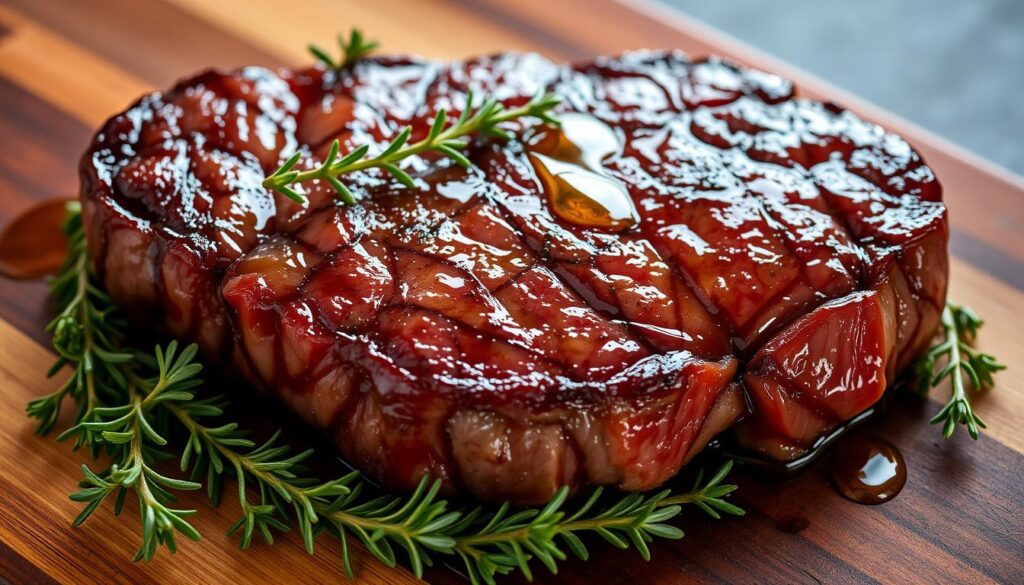
Recommended Resting Time
The ideal resting time for a Denver steak depends on its thickness, but generally falls within 5-10 minutes. A good rule of thumb is to rest your steak for approximately half the time it took to cook. During this period, it’s advisable to loosely tent the steak with foil to prevent it from cooling too much while allowing some steam to escape.
- Resting enhances the tenderness and flavor of the steak.
- A properly rested Denver steak retains more juices.
- Tenting with foil helps maintain the steak’s temperature and prevents sogginess.
By incorporating this simple step into your cooking routine, you’ll significantly improve the quality of your Denver steak. Whether you’re a seasoned chef or a culinary novice, understanding the importance of resting your steak is key to achieving a superior dining experience.
Serving Suggestions for Denver Steak
Discover how to pair your Denver steak with the perfect sides and wines for a memorable meal. Serving Denver steak is more than just the steak. It’s about finding the right balance of flavors and textures to make your meal special.
Pairing with Side Dishes
Choose side dishes that contrast with the Denver steak’s rich flavor. Here are some great options:
- Roasted garlic mashed potatoes for a comforting, savory match.
- Grilled asparagus with lemon, providing a bright, refreshing contrast.
- Sautéed mushrooms with thyme, adding an earthy depth to the meal.
- A crisp arugula salad with shaved parmesan and balsamic glaze, adding a tangy, peppery note.
For those who like to try new things, consider these options:
- Blue cheese polenta, rich and creamy with a pungent kick.
- Chimichurri roasted vegetables, bringing a vibrant, herby flavor.
- Truffle parmesan fries, decadent and indulgent.
Ideal Wine Choices
Choosing the right wine for your Denver steak depends on how you’ve seasoned it. For simply seasoned steaks, a medium to full-bodied red wine like Cabernet Sauvignon, Malbec, or Syrah is a classic choice.
If your steak has more complex flavors, you might want to try:
- Zinfandel, with its bold fruit flavors.
- Tempranillo, with balanced acidity and moderate tannins.
- Certain full-bodied white wines, like an oaky Chardonnay, which can complement specific flavors.
If you prefer not to drink wine, there are other options. Craft root beers, sparkling water with bitters, or specific teas can also enhance your meal.
| Steak Preparation | Recommended Wine | Alternative Pairings |
|---|---|---|
| Simply seasoned | Cabernet Sauvignon, Malbec, Syrah | Craft root beers, sparkling water with bitters |
| Complex seasonings or sauces | Zinfandel, Tempranillo, oaky Chardonnay | Specific tea preparations, flavored sparkling water |
Common Mistakes to Avoid
Even experienced cooks can make mistakes when preparing Denver steak. Knowing these errors can help you make a perfect dish. Cooking Denver steak to perfection needs attention to detail and knowledge of common pitfalls.
Overcooking Your Steak
One big mistake is overcooking Denver steak. It’s best cooked to medium-rare or medium doneness. This prevents it from becoming tough and dry. A reliable meat thermometer is key to avoid overcooking. Also, remember that the steak will cook a bit more after it’s removed from heat.
- Use a meat thermometer to check internal temperatures.
- Understand that carryover cooking will continue to cook the steak slightly after it’s removed from heat.
- Don’t press down on the steak with your spatula, as this can squeeze out juices.
Skipping the Resting Period
Another mistake is skipping or shortening the resting period. This period allows juices to redistribute, making the steak more flavorful and tender. Cutting into the steak too soon can lose these juices, making it dry.
- Cooking cold steak straight from the refrigerator, which can lead to uneven cooking.
- Over-flipping the steak, which can prevent proper crust formation.
- Using dull knives when slicing, which can tear the meat fibers instead of cutting them cleanly.
- Improperly seasoning the steak, either too early or too late, affecting the overall flavor.
By knowing these common mistakes and avoiding them, you can make sure your Denver steak is perfectly cooked and full of flavor. Whether you’re a seasoned chef or a novice, understanding these pitfalls is essential for a delicious Denver steak dish.
Tips for Leftover Denver Steak
Don’t let leftover Denver steak go to waste. Turn it into another tasty meal. With the right handling and creative recipes, it can be just as good as the first time.
Storing Leftovers Properly
To keep your leftover Denver steak fresh and safe, proper storage is key. First, cool the steak to room temperature within two hours of cooking to stop bacteria from growing. Then, wrap it tightly in plastic wrap or foil to keep air out, which can dry out the steak.
For short-term storage, put the wrapped steak in the coldest part of your fridge. It can stay there safely for 3-4 days. If you won’t eat it in that time, freeze the steak to keep it longer. Freezing works best if you slice the steak thinly, making it easier to thaw and reheat just what you need.
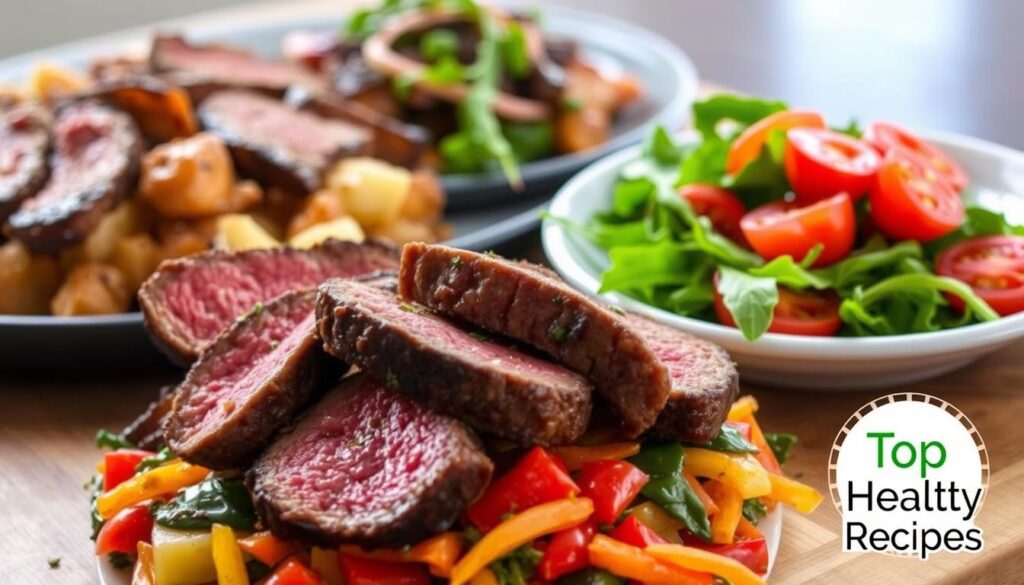
Creative Recipes for Leftovers
Leftover Denver steak can be turned into many tasty dishes. Here are some ideas to get you started:
- Gourmet Sandwiches: Slice the steak thinly and put it on a crusty baguette with caramelized onions and horseradish sauce for a tasty steak sandwich.
- Breakfast Hash: Dice the leftover steak and mix it with diced potatoes, onions, and bell peppers, topped with eggs for a filling breakfast.
- Pasta Dishes: Add sliced or diced steak to pasta like stroganoff or carbonara for more protein and flavor.
- Stir-Fries: Stir-fry the steak with your favorite veggies and serve over rice or noodles for a quick and easy meal.
- Salads: Mix sliced steak with mixed greens, blue cheese crumbles, and walnuts for a refreshing salad.
When reheating your leftover Denver steak, bring it to room temperature first. Then, warm it gently with low heat to avoid overcooking. Adding sauces or dressings can also help keep the steak tender and flavorful.
Nutritional Benefits of Denver Steak
Denver steak is not just tasty; it’s also packed with nutrients. Adding it to your meals brings tenderness and a wealth of health benefits.
It’s a top-notch protein source, vital for your body. A 6-ounce serving has about 40-45 grams of protein. This protein has all the amino acids your body needs for muscle repair, immune health, and more.
Protein Content and Benefits
The protein in Denver steak is easy for your body to use. This makes it a great choice for boosting your protein intake. It’s great for muscle health, helping those who are active or want to keep muscle mass as they get older.
Vitamins and Minerals in Denver Steak
Denver steak is also full of vitamins and minerals. It’s a rich source of B vitamins, like B12 and B6. B12 is key for nerve health and making red blood cells, while B6 is important for brain function. It also has zinc for immune health, iron for blood, phosphorus for bones, and selenium as an antioxidant.
Eating Denver steak can help meet your daily nutritional needs. But, remember to eat it as part of a varied diet. This way, you get the most from Denver steak while keeping your diet balanced and diverse.
How to Slice Denver Steak Properly
Slicing a Denver steak right is an art. It starts with knowing the meat’s grain. The grain is the muscle fibers’ direction. In Denver steak, these fibers can run in different ways, so it’s key to spot the grain correctly.
Understanding the Grain of the Meat
To find the grain, look for lines or striations on the steak’s surface. These lines show the muscle fibers’ direction. With Denver steak, the grain might change within the same cut. You need to watch closely to see where the grain goes.
After spotting the grain, slice the steak against it. Cutting against the grain means you slice across the lines you see. This makes the steak tender and easy to chew.
Techniques for Slicing for Tenderness
To make your Denver steak tender, follow these steps:
- Use a sharp knife, like a slicing knife or a sharp chef’s knife.
- Cut at a slight angle for better tenderness and looks.
- Keep your slices the same thickness, about ¼ to ½ inch.
- Let the steak rest completely before slicing to keep juices in.
If your Denver steak has different grain directions, adjust your slice direction as needed. This way, you’re always cutting against the grain, no matter its direction.
| Slicing Technique | Benefit |
|---|---|
| Slicing against the grain | Increases tenderness by shortening muscle fibers |
| Cutting at a slight angle | Enhances visual appeal and tenderness |
| Consistent slice thickness | Ensures even cooking and texture |
“The way you slice your steak can elevate the dining experience. It’s not just about the cooking; it’s about the presentation and the tenderness you achieve by slicing correctly.”
Denver Steak vs. Other Cuts
The world of steak can be overwhelming. But, comparing Denver steak to other cuts can help you choose wisely. Denver steak is known for its tenderness and rich flavor. It’s often compared to other popular steak cuts.
Comparing Flavor and Texture
Denver steak has a unique flavor and tenderness. It has more marbling than flank or skirt steak, making it tender and flavorful. While it’s not as soft as filet mignon, its flavor is similar to ribeye.
Denver steak’s tenderness comes from its muscle structure, from the chuck section. It’s more tender than many chuck steaks. Its marbling makes it juicy and flavorful, a favorite among steak lovers.
- Flavor Profile: Denver steak has a robust beefy flavor, similar to ribeye, but with its own distinct character.
- Tenderness: It is more tender than flank steak and many chuck steaks, though not as tender as filet mignon.
- Marbling: The marbling in Denver steak contributes to its juiciness and flavor, making it more enjoyable than leaner cuts.
Cost-Effectiveness of Denver Steak
Denver steak is a cost-effective option. It’s a newer cut, so it’s not as pricey as traditional favorites. This means you can enjoy a high-quality steak without spending a lot.
Denver steak costs 30-50% less than ribeye or strip steak. It’s a great choice for those who want to impress without spending a lot. The quality is high, just like more expensive cuts.
To find the best deals on Denver steak, shop during seasonal sales or from local butchers. They might offer better prices. This cut is a smart choice for anyone looking to impress without breaking the bank.
Tips for Cooking Steaks on a Budget
You don’t have to spend a lot to enjoy a great Denver steak. With a few easy tips, you can make a tasty meal without spending too much.
Affordable Seasoning Options
Seasoning your Denver steak doesn’t have to cost a lot. You can use simple things from your pantry to get gourmet results. Just mix kosher salt, black pepper, and garlic powder for amazing flavor.
- Kosher salt brings out the steak’s natural taste
- Black pepper adds a classic flavor
- Garlic powder adds a savory touch
For more complex flavors, try using brown sugar, paprika, dried herbs, and chili powder. These can make your own rubs that are just as good as the expensive ones.
Cost-Saving Cooking Techniques
To save money and get tender, flavorful steaks, try these tips:
- Proper tenderizing techniques: Use salt-based dry brining to make the steak tenderer.
- Optimal cooking methods: Reverse searing is better and cheaper than traditional methods.
- Batch cooking strategies: Cook several steaks at once to save money.
Also, don’t waste anything. Use steak trimmings for stocks or stir-fries. Turn leftover steak into new meals with creative recipes for Denver steak.
With these tips, you can enjoy a delicious Denver steak without spending too much. Try different how to cook a Denver steak ways to find your favorite.
Where to Buy Quality Denver Steak
Finding high-quality Denver steak is key for a great meal. You can buy it from several places, each with its own benefits.
Purchasing Options
Local butchers offer top-notch quality and expert advice. They work with local farms, sharing info on the meat’s background and best cooking ways. Buying from a butcher lets you learn about the steak’s raising and get cooking tips.
Supermarkets are another choice, with convenience and sometimes cheaper prices. Upscale grocery stores with meat counters can match the quality of specialty butchers. Look for stores known for their meat department when shopping at supermarkets.
Online Meat Sources
Online meat sellers have changed how we get premium beef. Sites like Crowd Cow, ButcherBox, and Snake River Farms sell Denver steak with clear sources and grading. When buying online, check the shipping and customer service.
When choosing, look for good marbling, aging, and thickness. Knowing USDA grades (Prime, Choice, Select) helps too. By picking the right Denver steak and following cooking tips, you’ll make a dish that wows.
FAQ
What is Denver steak and where does it come from?
How do I cook a Denver steak to the perfect doneness?
What are some recommended seasoning techniques for Denver steak?
Can I grill Denver steak, and if so, what’s the best way to do it?
How do I store leftover Denver steak, and what are some creative ways to use it?
What are the nutritional benefits of Denver steak?
How do I slice Denver steak properly to maximize tenderness?
Is Denver steak a cost-effective option compared to other steak cuts?
Where can I buy high-quality Denver steak?
What are some budget-friendly tips for cooking Denver steak?
For more cooking tips, stay connected with us. We also recommend the cookbook Skinnytaste Simple: Easy, Healthy Recipes with 7 Ingredients or Fewer
For more Recipes about Steak ?
Did You try our recipe ?
There are no reviews yet. Be the first one to write one.
